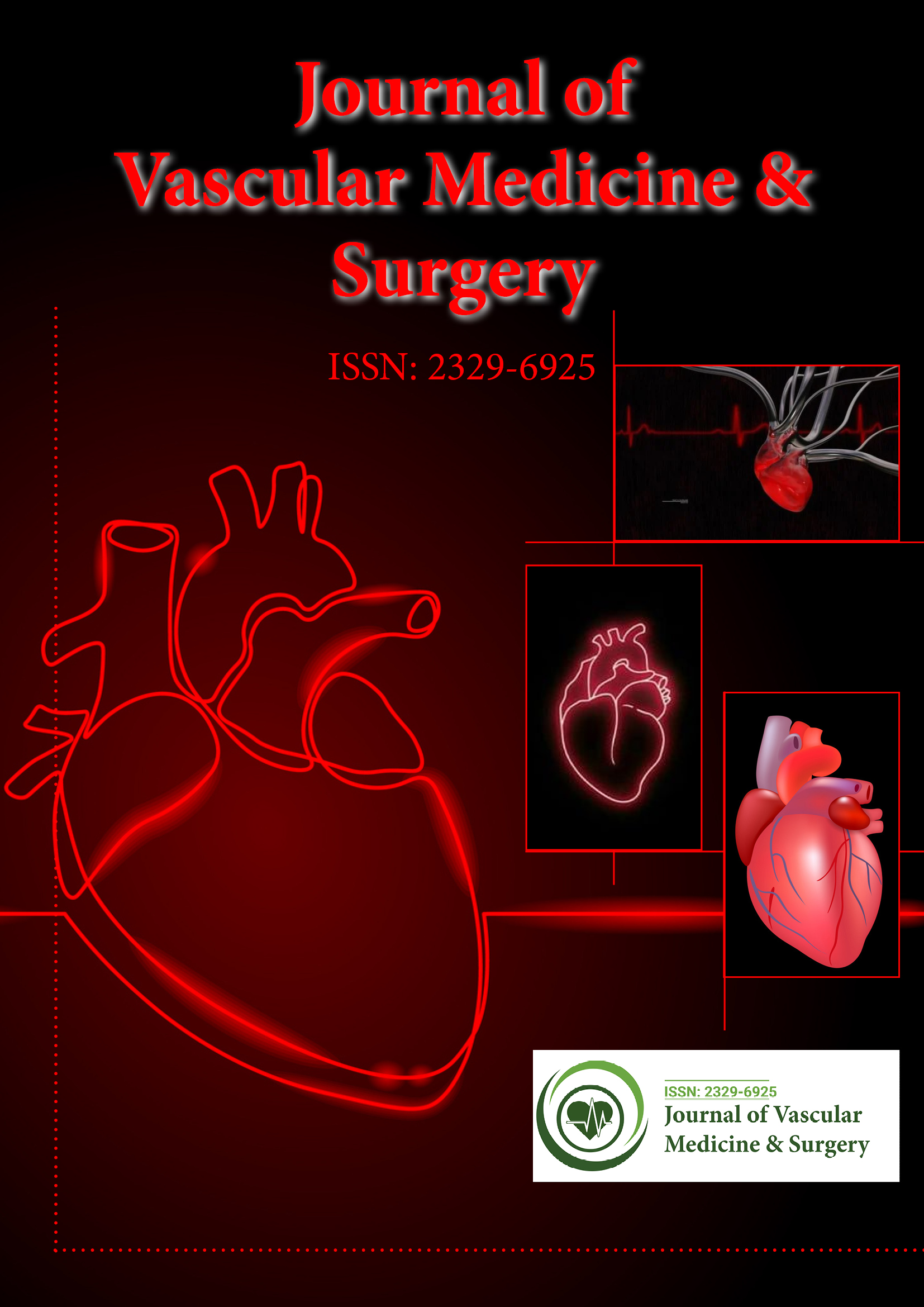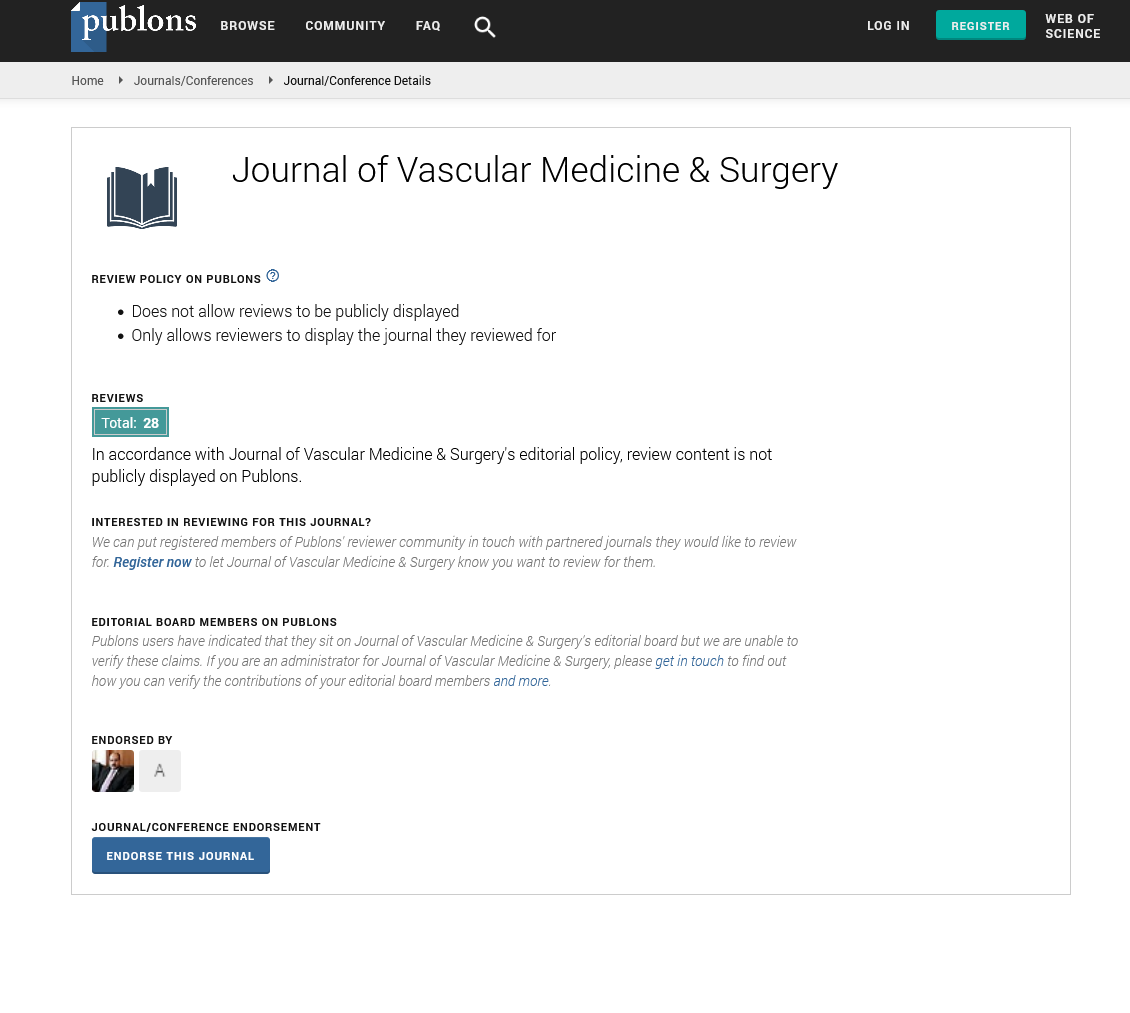Indexed In
- Open J Gate
- Academic Keys
- RefSeek
- Hamdard University
- EBSCO A-Z
- OCLC- WorldCat
- Publons
- Euro Pub
- Google Scholar
- SHERPA ROMEO
Useful Links
Share This Page
Journal Flyer

Open Access Journals
- Agri and Aquaculture
- Biochemistry
- Bioinformatics & Systems Biology
- Business & Management
- Chemistry
- Clinical Sciences
- Engineering
- Food & Nutrition
- General Science
- Genetics & Molecular Biology
- Immunology & Microbiology
- Medical Sciences
- Neuroscience & Psychology
- Nursing & Health Care
- Pharmaceutical Sciences
Commentary - (2025) Volume 13, Issue 7
Advancing Vascular Care: Challenges, Breakthroughs, and Solutions
Liam Jenson*Received: 18-Jun-2025, Manuscript No. JVMS-25-29906; Editor assigned: 20-Jun-2025, Pre QC No. JVMS-25-29906 (PQ); Reviewed: 04-Jul-2025, QC No. JVMS-25-29906; Revised: 11-Jul-2025, Manuscript No. JVMS-25-29906 (R); Published: 18-Jul-2025, DOI: 10.35248/2329-6925.25.13.608
Description
Vascular care, the branch of medicine dedicated to the diagnosis and treatment of diseases affecting the blood vessels, is undergoing a transformative phase. With the increasing burden of cardiovascular and peripheral artery diseases globally, the spotlight on vascular health has never been more critical. Yet, despite significant strides in research and technology, advancing vascular care remains a multifaceted challenge. It is a field shaped by evolving patient demographics, rising comorbidities, disparities in access to care, and a rapidly shifting technological landscape.
The complex landscape of vascular health
One of the primary challenges in vascular care is the silent progression of many vascular diseases. Conditions such as Peripheral Artery Disease (PAD), aortic aneurysms, and carotid artery disease often remain asymptomatic until they reach an advanced or life-threatening stage. This delay in detection leads to poor outcomes, including limb loss, stroke, or even death. The asymptomatic nature of these conditions makes early intervention difficult, especially in resource-constrained settings where regular screening is not a routine part of care.
Moreover, lifestyle-related risk factors, such as diabetes, obesity, smoking, and hypertension, continue to rise worldwide. These comorbid conditions not only accelerate the progression of vascular diseases but also complicate treatment. In aging populations, these risk factors compound, making the clinical management of vascular conditions increasingly complex. In particular, diabetic patients often suffer from small vessel disease, which presents unique therapeutic challenges, often resisting conventional revascularization procedures.
Healthcare systems around the world also face significant disparities in the provision of vascular care. In many low- and middle-income regions, there is a shortage of trained vascular specialists and a lack of essential diagnostic tools, such as duplex ultrasound or CT angiography. This inequality leads to late presentations and limited treatment options, often resulting in preventable complications. Even in more developed healthcare systems, rural and underserved populations experience gaps in access, leading to higher rates of amputation and mortality.
The economic burden of vascular diseases is another pressing issue. Costs associated with repeated hospitalizations, surgical interventions, long-term medications, and rehabilitation services place a strain on both patients and national healthcare systems. These financial barriers can deter individuals from seeking timely care, especially in systems with limited insurance coverage or high out-of-pocket expenses. Thus, affordability and accessibility must be part of any conversation on improving vascular outcomes.
Innovative breakthroughs and future-focused solutions
Despite these formidable challenges, the field of vascular care is not static—it is marked by dynamic innovations and evolving solutions that are reshaping how vascular diseases are diagnosed, managed, and treated. From cutting-edge imaging technologies to minimally invasive surgical techniques, the breakthroughs of the last two decades have laid the groundwork for a more precise and patient-centered approach.
Endovascular procedures, for instance, have revolutionized the way many vascular conditions are treated. Techniques such as angioplasty, stenting, and Endovascular Aneurysm Repair (EVAR) offer less invasive alternatives to traditional open surgeries. These procedures often result in shorter hospital stays, faster recovery times, and fewer complications, particularly for elderly or high-risk patients. As device technologies continue to improve, with more flexible and durable stents and grafts, endovascular treatment is expanding its reach to more complex cases that were once deemed inoperable.
Advancements in imaging have also played a critical role in improving diagnostic accuracy and guiding interventions. High-resolution vascular ultrasound, Magnetic Resonance Angiography (MRA), and three-dimensional CT angiography have enhanced our ability to visualize vascular anatomy in great detail. These tools not only support earlier diagnosis but also enable real-time decision-making during interventions, improving both safety and outcomes.
Machine learning are beginning to show promise in vascular medicine as well. Predictive algorithms can help identify patients at high risk of vascular events, enabling targeted prevention strategies. AI-powered imaging interpretation can assist clinicians in detecting subtle abnormalities that may otherwise be overlooked. As these technologies mature, they are expected to further personalize care, reduce human error, and streamline workflow in busy clinical settings.
Another emerging frontier is the use of regenerative medicine and bioengineering to repair or replace damaged blood vessels. Researchers are exploring the potential of stem cell therapy, tissue scaffolding, and 3D printing in creating vascular grafts that mimic natural vessels. While still largely in experimental stages, these innovations hint at a future where complex vascular reconstructions could be performed with biologically compatible materials, reducing the risk of rejection and complications.
Digital health and telemedicine also offer practical solutions, particularly in bridging the gap in access to vascular care. Remote monitoring tools, wearable devices, and mobile health applications can help track blood pressure, glucose levels, and other vital parameters in real time. This empowers patients to take an active role in their own care and allows clinicians to intervene early when signs of deterioration appear. In rural or underserved areas, virtual consultations can connect patients with vascular specialists without the need for travel, thus expanding the reach of expert care.
Conclusion
The journey to advance vascular care is both inspiring and demanding. It is a path marked by significant obstacles but also illuminated by breakthroughs that are reshaping possibilities. As the burden of vascular disease continues to grow globally, it is imperative that healthcare systems respond with urgency, innovation, and equity. The integration of cutting-edge technology, policy reform, and collaborative care models offers a clear roadmap to a future where vascular diseases are not only treatable but largely preventable.
Citation: Jenson L (2025). Advancing Vascular Care: Challenges, Breakthroughs, and Solutions. J Vasc Surg. 13:608
Copyright: 2025 Jenson L. This is an open-access article distributed under the terms of the Creative Commons Attribution License, which permits unrestricted use, distribution and reproduction in any medium, provided the original author and source are credited

